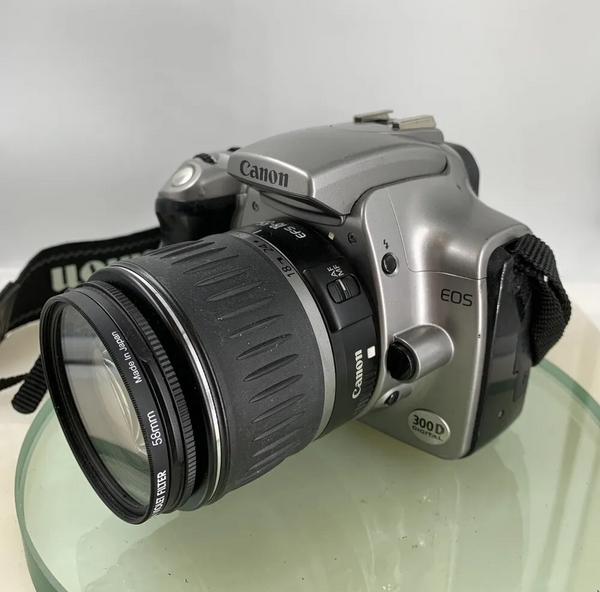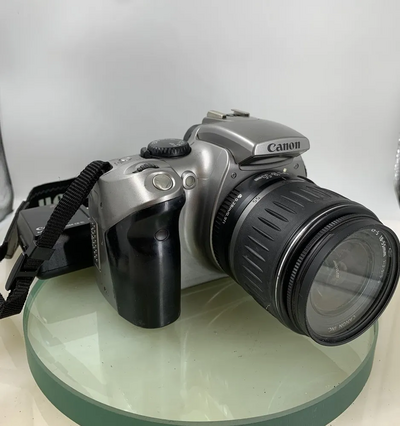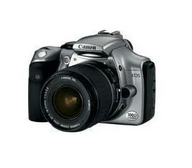
Canon 300D / Digital Rebel
| Brand | Canon 2003 |
| Model | 8862A002 |
| Released Year | 2003 |
| Type | Digital Cameras |
| Series | Eos |
| Autofocus | 7 point TTL-CT-SIR phase detection |
| Status | Discontinued |
Quick view
Overview
The Canon EOS 300D, also known as the Digital Rebel in North America, was one of the first affordable digital SLR cameras aimed at entry-level users. It features an 6.3-megapixel APS-C CMOS sensor with a resolution of 3,072 x 2,048 pixels, supporting high-quality image capture. The camera utilizes the Canon EF and EF-S lens mount system compatible with a wide range of lenses. It is equipped with a 7-point autofocus system and a TTL-CT-SIR phase-detection autofocus sensor for fast focus. The shutter speed ranges from 30 seconds to 1/4000 seconds, allowing flexible exposure control. It supports CompactFlash Type I and II memory cards for storage and has a 1.8-inch color LCD for image review and menu navigation.
The camera runs on a rechargeable NiMH battery pack providing sufficient power for a typical shoot session. ISO sensitivity ranges from 100 to 1600, allowing for decent performance in various lighting conditions. The body dimensions are compact for an SLR and relatively lightweight, designed for ease of handheld shooting. It has a built-in pop-up flash and supports various exposure modes including aperture priority, shutter priority, and manual mode. Image file formats supported are JPEG and RAW (CRW), which provide flexibility for post-processing. Connectivity options include USB 1.1 for image transfer to computers. The 300D was a milestone in making digital SLR photography accessible to a wider audience due to its price and user-friendly features.
Specifications
| MPN | 8862A002 |
| EAN | 4960999191485 |
| Model | 300D / Digital Rebel |
| Battery Type | Lithium-Ion |
| Connectivity | USB |
| Colour | Silver |
| Features | Histogram Display, Direct Print, AE/FE Lock, Rgb Primary Colour Filter, DPOF Support, Auto Power Save, Camera Orientation Detection, PictBridge Support, Digital Image Rotation, Date/Time Stamp, Backlight Compensation, Depth-Of-Field Preview Button, Display Drightness Control |
| Series | Canon EOS |
| Type | Digital SLR |
| Depth | 7.24cm |
| Height | 9.9cm |
| Width | 14.2cm |
| Item Weight | 560GR |
| Display Type | LCD |
| Sensor Resolution | 6.3MP |
| Display Size | 1.8in |
| Screen Size | 1.8in |
| Camera Type | Digital SLR |
| Maximum Resolution | 6.3MP |
| Lens for Sd | Ef-S 18-55mm |
| Supported Flash Memory | Compactflash I, Compactflash Ii |
| Sensor Type | APS-C CMOS |
| Effective Pixels | 6.3 Megapixels |
| Image Resolution | 3072 x 2048 pixels |
| Lens Mount | Canon EF and EF-S |
| Viewfinder | TTL Optical Pentamirror with approx. 95% coverage |
| Autofocus | 7 point TTL-CT-SIR phase detection |
| ISO Sensitivity | 100 - 1600 |
| Shutter Speed | 30 - 1/4000 sec |
| Storage Media | CompactFlash Type I/II |
| File Formats | JPEG, RAW (CRW) |
| LCD Monitor | 1.8 inch color TFT LCD |
| Flash | Built-in pop-up flash |
| Exposure Modes | Auto, Program AE, Shutter priority, Aperture priority, Manual |
| Battery | Rechargeable NiMH battery pack |
| Dimensions (WxHxD) | 142 x 99 x 72 mm |
| Weight | Approx. 560 grams (body only) |
| Interface | USB 1.1 |
Images
Key Advantages
The Canon EOS 300D provided remarkable value by offering a 6.3-megapixel APS-C sensor in an affordable price range. Its compatibility with Canon's EF and EF-S lens lineup offered extensive creative control with lenses. The lightweight and compact body improved portability without sacrificing functionality. It featured a user-friendly interface and exposure modes, making it accessible to beginners and enthusiasts. The 7-point autofocus system enhanced focus accuracy and speed for most shooting situations. It supported RAW file capture, allowing professional-grade image post-processing flexibility.
Limitations
The image resolution of 6.3 megapixels is modest by modern standards and limits large format printing quality. The 1.8-inch LCD screen is relatively small and low-resolution for detailed image review. The ISO range of 100-1600 can struggle in low-light without flash, producing noticeable noise at higher sensitivities. The camera uses CompactFlash Type I/II cards which have slower data transfer speeds compared to newer memory cards. The USB 1.1 interface restricts rapid file transfer, creating delays with large image files. The NiMH rechargeable battery is bulkier and offers less capacity compared to modern lithium-ion batteries.
FAQ
What is the sensor resolution of the Canon EOS 300D?
The Canon EOS 300D features a 6.3-megapixel APS-C size CMOS sensor, offering a resolution of 3072 x 2048 pixels.
Which lens mounts are compatible with the Canon EOS 300D?
It is compatible with Canon EF and EF-S lenses, providing a wide range of lens options.
What types of storage media does the Canon EOS 300D support?
The camera supports CompactFlash Type I and Type II memory cards for image storage.
Does the Canon EOS 300D support RAW image capture?
Yes, it supports RAW file format (CRW) in addition to JPEG, allowing for advanced image editing.
What is the ISO sensitivity range of the Canon EOS 300D?
The ISO range is from 100 up to 1600, suitable for various lighting conditions though higher ISO may introduce noise.
What battery type does the Canon EOS 300D use?
It uses a rechargeable NiMH battery pack designed specifically for this model.
Is the Canon EOS 300D still supported or discontinued?
The Canon EOS 300D has been discontinued and is no longer in production.
Disclaimer
The content on is provided for general informational purposes only. We do not guarantee the accuracy, completeness, or reliability of any information, specifications, or visuals presented on the site.
is not responsible for any content, images, or data uploaded or shared by users. Users are solely responsible for the content they submit.
We may include links to third-party websites for convenience. We do not endorse or take responsibility for the content or policies of any external sites.
Use of the site is at your own risk. Always verify critical information independently before making decisions based on content from this website.






